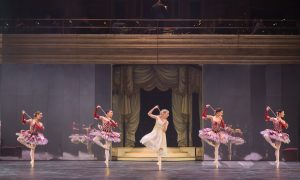Myriad questions swirl in the ether of today’s dance and performing arts sector. Why are we still mostly seeing the same kind of bodies onstage, and the same kind of people in the audience? Who has access to the resources it takes to develop artistic craft, and who doesn’t? Traditional structures created the field as it is – what within those structures will continue to serve us, and what won’t? What are best practices for addressing these crucial matters?
London’s Sadler’s Wells is making its own efforts at doing just that, such as its Artist Development Programmes, including the Disabled Artists Programme, South Asian Dance Development Programme, Time and Space Commissions, and Mentorship Programme. To learn more about these programmes – the why, what, where to from here, and more – we’ll hear from Rob Jones, Associate Artistic Director at Sadler’s Wells.
The “why”
Sadler’s Wells Artist Development Programmes aim to nurture “dance in all its forms,” as well as all types of dance artists, “regardless of pathway, training or background.” They’re “part of a new conversation that we’re having as an organisation,” Jones explains. That conversation is looking at how “there are forms in the dance ecosystem that are underserved, as well as gaps in the types of bodies that are on stage.”
To Jones, these programmes have potential to “set a different tone [with respect to] who is onstage and who is in the audience”, to defy the idea out there that there are certain people who “don’t have a place” within an institution like Sadler’s Wells.
These programmes can also challenge notions that producing creative product reigns supreme over artistic development and process – while it is simultaneously more and more challenging to get work funded and produced. The dance sector is “a competitive environment…certain artists can thrive [within it], but some really can’t,” Jones observes.

He believes that Sadler’s Wells, as an internationally-recognized field leader, is positioned to set a meaningful example here. “When we do something, the field takes note,” Jones argues. A more inclusive, expansive way of operating also simply results in more interesting art, Jones affirms.
Sadler’s Wells is, and will remain, a commercial organisation, he also notes. It’s primarily a presenting house, with a limited impact in these areas. Yet, this action does mean something, and is “way overdue,” Jones believes. “We have to try to do things differently, or we’re just going to get the usual suspects coming through,” he believes. “You can’t want to see change but keep doing things the same way…that’s the definition of insanity, right?” he quips.
How it works and how it’s going
“Process over product” encapsulates a lot of how these programmes operate. “We’re holding space for development – space for artists to think and to interact – versus ‘teaching them how to be a choreographer’,” Jones explains. Each cycle is two years, and these programmes are currently in Cycle 1. “It’s not about being in front of an audience in this cycle,” Jones explains. “We’re trying to remove the pressure of making [something for the stage].”
That structure also allows participants “an element of privacy”; no one needs to know how it’s all going except for those in the programme and those to whom they decide to disclose that information. They do have mentors to guide them through that growth, as well as lots of structured activity designed to nurture their creative development.
What might that activity look like? Artists can broaden their artistic palette and become more versatile through trying different styles. They come with “creative questions,” Jones notes – which they, their peers and their mentors can together investigate. There are also Artist-Led sessions, which programme participants design. “It’s about community-building, introspection and engagement with other artists,” Jones says.
Artists have come from all over the UK for the programme, to experience those processes and work within those values. Some of the participants have even come all the way from Liverpool, Jones shares. “I felt badly about that at first, but then I realized that we might be the only ones” offering something like this, he reflects.
So, all of that said, how’s it going? “We’re approaching the end of year one, and so far so good. Everything’s been well-received, and all of the artists we’ve engaged with are buzzing. It’s a really good vibe!” Jones says. “You can see that something really powerful is happening” when these artists come together, he continues.
In particular, he mentions the South Asian dance cohort. All of those artists are female, but not all of them are South Asian in ethnicity. “They’re working through that discomfort, as well as working on what their practice is and what they want it to be,” he explains. “You can feel that they’ll go on to do great things.” For their part, the mentors in all of the programmes – “some true heavy hitters in the field, and incredibly busy,” Jones notes – have been remarkably generous with their time and expertise.
Where it goes from here
“Some strands of these programmes will wake up, and some go to sleep, in Cycle 2,” Jones explains. There will be some presentation models in Cycle 2, for example. At that point, he would like “to push artists to work at scale, and to have a touchpoint with audiences.” Encountering that at some point matters, because “the only way to do it is to do it….you ‘fail’ and try again,” Jones argues. With fewer and fewer “testing grounds” in the UK, Sadler’s Wells could serve an important role in offering such a space.
Jones also notes a severe shortage of producers in the UK – and, while nothing is currently planned there with respect to these Artists Development Programmes, Sadler’s Wells is considering models for nurturing that workforce.
Additionally, some of the Artist Development Programmes, such as the South Asian Dance Development Programme, will go on pause. Others, such as the Disabled Artists programme, will remain. “We need to have that,” Jones affirms, “and a community will grow out of it.”
All in all, it’s a work in progress – “iterative” and “able to be tweaked”, Jones says – just like the things that programme participants are creating. Of Sadler’s Wells, “It’s been a really interesting journey to see the organization work in this way,” Jones says. “Not everyone is good at opening these spaces, or interested in it. But if you are…we’re at a point now that we can do better, we should. There’s power in that.” With a lot feeling “janky” in the UK’s arts ecosystem right now, as Jones sees it, such power could lie in making that ecosystem more vibrant, more resilient and more impactful.
As for programme artists, who will be the “next wave” in that ecosystem, Jones has a lot of hope for who they could become and what they could accomplish. “There are so many talented artists out there who have done great things, and we want them to be acknowledged,” he says. “It feels like we’re building a powerhouse, and I’m really interested to see where it goes!”
For more information, visit www.sadlerswells.com/for-artists/artist-development.
By Kathryn Boland of Dance Informa.










